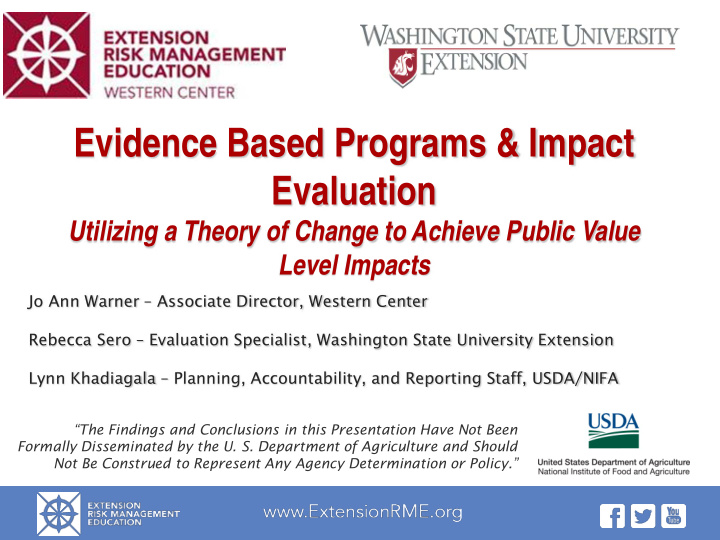



Evidence Based Programs & Impact Evaluation Utilizing a Theory of Change to Achieve Public Value Level Impacts Jo Ann Warner – Associate Director, Western Center Rebecca Sero – Evaluation Specialist, Washington State University Extension Lynn Khadiagala – Planning, Accountability, and Reporting Staff, USDA/NIFA “The Findings and Conclusions in this Presentation Have Not Been Formally Disseminated by the U. S. Department of Agriculture and Should Not Be Construed to Represent Any Agency Determination or Policy.”
Western Extension Risk Management Education Center (Western Center) One of four regional Extension risk management education centers in the U. S. Administer a competitive grants program in the 13 western states and U.S. affiliated Pacific Islands Supported by funding from the USDA National Institute of Food and Agriculture (NIFA) http://westrme.wsu.edu/
Extension Risk Management Education Our Goal To help farm and ranch families improve their economic viability through targeted risk management education.
Evidence Based Program s: An Overview
Evidence Based Programs … . • Benefit Participants • Lead to Improved viability and effectiveness of programs and policies • Create rigorous and meaningful evidence as a routine part of program delivery. • Impart additional value to those who do not directly benefit from a program. • End Result: Ability to contribute effectively to data systems and inform public policy
Theory of Change & Public Value Level Impacts Underlying assumptions or rationale for how your project activities will lead participants to the desired results Why will the outcomes your project proposes make a difference? What gaps will your program aim to fill? For the individual? For the community? Why is this significant to food and ag? Sets up context at local, regional and national levels
Theory of Change: Working Back from Your End Goal 1. End Goal = long-term impact(s) a) Societal or public value that will come about as a result of your program 2. Long-term program outcomes – benefits accrued to participants 3. Short- and medium-term outcomes a) Necessary pre-conditions for long term outcomes and impact: i. Activities ii. Actions/behavioral change iii. Strategies
Theory of Change Results in: Reliable Evidence to Support and/or Inform Policy Gathering Evidence – Measuring Change Necessary Program Pre- Delivery Conditions PRODUCTION TOPIC AREAS – NEW TOOLS AND PRACTICES Use of Baseline/Benchmarking Data: Compare/Contrast
Value of Using Baseline/ Benchmarking Data 1. Producers current cost of production 2. Cost variance data for traditional/commodity operations and differentiated enterprises 3. Processor price data **Cross correlate above with United States Census of Agriculture, USDA National Agricultural Statistics Service (NASS), Agricultural Resource Management Survey (ARMS), Economic Risk Survey (ERS), etc. Creates an ongoing feedback system to validate long-term outcomes and impacts Compares current conditions to baseline measures as your project progresses Data collection as an ongoing process Evaluation conducted at multiple points in time
Systems Evaluation Model Grounded in a Theory of Change
Systems Evaluation Model Grounded in a Theory of Change
1. Adopt a data driven 1. Transitioned herd 1. % Increase in profit market strategy for from commodity to from higher prices interaction with differentiated received in specific meat markets differentiated processing outlets 2. Converted herd to markets; i.e. certified BQA/Grassfed/USD management and A Certified Organic marketing plan; i.e. 2. % reduction in BQA/Grassfed/Sust variable ainably raised transportation 3. Improved costs coordination with 3. % reduction in processing processing facilities livestock 4. % reduction in overall cost of livestock finishing Outcome measures lead to multiple and related benefits – ultimately benefiting the producers’ bottom lines.
Theory of Change: What to Measure End Goal: Assess current value chain restraints and opportunities so that long term improvements can be made to the livestock value chain Activities & Outcomes will fill gaps in the livestock value chain by addressing: i. Processing capacity ii. Communication/coordination between processors and producers iii. Existing and emerging market opportunities iv. Cost of Production for livestock finishing: Goal – decrease costs v. Cost differences differentiated vs commodity sales: Goals – increase revenue/sales, growth in sales volume
Theory of Change: What to Measure • End goals produce far reaching effects (Public Value Level Impacts) • Lead to ability to make informed choices • Validate effectiveness of (government) programs and policy **Impacts can be thought of as the longer-term effects of outcomes
Gathering Quality Data • Develop detailed evaluation questions that will answer the expectation of what you want your participants to achieve (outcomes). • Will these questions and resulting data (from participant responses) 1. Serve the interests of your participants? 2. Serve the interest of your program? 3. Serve the interests of your regional leadership and stakeholder partners? 4. Lead to Public Value Level Impacts – i.e. impacts with far reaching effects?
Gathering Quality Data • Focus on evaluating results/outcomes versus activities • Create opportunities to use data for evidence building – Build program capacity – Elevate data (local/regional/state/national levels – Develop stakeholder partnerships **Improved quantity and quality of evidence leads to improved viability, program effectiveness, decision making and policy.
Thank you for participating… Questions? Jo Ann Warner warnerj@wsu.edu Rebecca Sero rsero@wsu.edu Lynn Khadiagala Lynn.Khadiagala@usda.gov
Recommend
More recommend